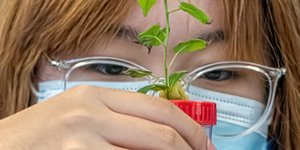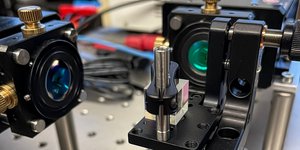Physics in Life Sciences

How does a laser work and how can we use it as a tool to watch individual proteins at work and even manipulate them? What is fluorescence and how does it help to better understand biological processes in cells? Why can the actually dangerous radiation from radioactive substances help treat cancer? In this course you will learn which physical methods are used to answer questions in the life sciences. We will work on these and other topics both in XLAB's own laboratories and together with scientists in their research institutes on the campus.
Quantum Physics

Modern quantum technologies are driven by the ability to control individual quantum objects. In the quantum physics course, you will perform hands-on experiments, calculations and simulations to gain insights into the fundamentals of technologies such as quantum computing and quantum cryptography. Topics include transitions between quantum mechanical states, light amplification by stimulated emission of radiation, quantum mechanical superposition, quantum mechanical measurements, experiments with single photons, and entanglement. Excursions to research facilities on the Göttingen Campus offer insights into current research in this field.
Light and Matter

In this course, you will learn how scientists use the interaction of light and matter to generate light and colors by chemical processes, up to building an organic light-emitting diode (OLED) yourself. We will also investigate chemical reactions driven by light, such as a photocatalytic model system for photosynthesis. We construct an organic photovoltaic cell to generate electricity and use molecular switch systems to investigate how self-tinting glasses work, for example. In addition, researchers who use the interaction of light and matter will report on their work.
Plastics: Production and Sustainability

Plastic is a double-edged sword: irreplaceable in medicine and other applications, but problematic in terms of production and disposal. In this course, we will investigate the production chains of petroleum-based plastics (e.g. PVC) and plastics based on renewable raw materials (e.g. wood). In addition to fractional distillation, catalytic cracking and decomposition by boiling under reflux, we perform modern analyses like mass spectrometry and gas chromatography. To analyze micro particles formed by decaying plastic, you detect them by fluorescence staining. If plastic waste is collected properly, however, it can be reprocessed with added value. We will produce nonwoven microfiber mashes that are used in modern filter systems by electrospinning. Basic knowledge of organic chemistry and laboratory techniques is recommended.
Molecular Medicine

Can life be extended indefinitely? Will we be able to cure diseases more effectively in the future? Questions like these are at the heart of modern life sciences.
In this course, we explore the fundamentals of cell activity using techniques such as microscopy, PCR, and bioinformatic analyses. Hands-on experiments in molecular biology, immunology, and pharmacology provide insights into current research and future challenges. The experience is rounded off with a visit to a research lab of the The University Medical Center Göttingen and an expert lecture, giving participants a direct glimpse into cutting-edge scientific work.
Prior knowledge of genetics is an advantage.
Lake Ecosystems: Function and Sustainability

Lakes host significant biodiversity and provide vital ecosystem services that support the livelihoods of hundreds of millions of people worldwide. However, these services are declining due to stressors such as climate change, eutrophication, and overuse. For example, a quarter of the global population lives in the catchment areas of drying lakes.
In this course, you will investigate lake ecosystems through hypothesis-driven research. Using professional equipment, you will collect vertical profiles of physico-chemical parameters and phytoplankton biomass, analyze nutrient concentrations, and identify plankton under the microscope to explore their lifestyles and ecological roles.
You will learn how lakes function as ecosystems and how their productivity and stability are shaped by interactions between lake characteristics (e.g., size, depth) and catchment features (e.g., area size, land use). You will also develop ideas for sustainable lake management.
Neurobiology

The high performance of our nervous system is based on a fundamental principle: the formation and controlled change of an electrical potential at the cell membranes of the neurons. In this course, we will analyze the resting membrane potential of individual cells as well as active and passive potential changes. We will learn how we can influence the membrane potential chemically and electrically and conclude what this means for the function of our nervous system. As an example of a sensory system, we will compare the visual system of humans and grasshoppers using self-experiments and electroretinograms (ERGs) of the insect eye. For this purpose, we will determine the flicker fusion frequency and analyze the spectral sensitivity of the locust eye. The central nervous processing of visual stimuli is investigated with extracellular recordings from the neck connectives of the migratory locust.